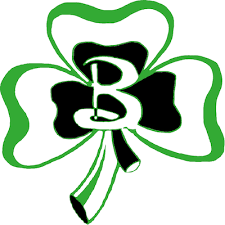
Berrien Springs at a Glance
Location: Berrien County, Michigan
NCES Designation: Town: Fringe
Number of School Buildings: 21
Total Staff (FTE): 318
Classroom Teachers (FTE): 165
Number of Students Served: 3,711
- Empowering Teachers and Capturing Kids’ Hearts®: The Public Schools of Calumet, Laurium, and Keweenaw’s Journey Toward Student-Centered Learning
Through Community and Culture, Oxford Community Schools Makes Learning Student-Centered
Introduction
In the southwest corner of Michigan, approximately 10 miles east of the sandy beaches of Lake Michigan and 20 miles north of South Bend, Indiana, is the rural farming community of Berrien Springs, home to Berrien Springs Public Schools. Also located in Berrien Springs is Andrews University, which draws students, faculty, and staff from all around the world. Berrien Springs Public Schools reflect the diversity of their community with over 30 countries represented within the population of their students and staff.
Berrien Springs Public Schools (BSPS) includes Mars Elementary (PK-2), Sylvester Elementary (3-5), Berrien Springs Middle School (6-8), Berrien Springs High School (9-12), Berrien Springs Discovery Academy (an alternative school serving students in grades 6-12), Berrien Springs Virtual Academy (KG-12), West Michigan Virtual Battle Creek Middle School (6-8) and High School (9-12), as well as 16 Link Learning locations (9-12) located throughout Michigan. BSPS main school buildings (Mars Elementary, Sylvester Elementary, Middle School, High School, Discovery Academy, and Virtual Academy) are conveniently located together on one central campus. While BSPS serves approximately 1,900 students on campus, they serve an additional 1,800 students statewide through their many Link Learning and West Michigan Virtual learning locations. In total, BSPS serves approximately 3,700 students, 57% of whom are White, 15% are Black, 17% are Hispanic or Latino, 6% are Asian, and 5% identify as “other.” Roughly 3% of students have an Individualized Education Plan (IEP) recommending service.
Driven by their commitment to what they call “The Shamrock Way,” Berrien Springs Public Schools offers personalized learning opportunities where students can learn and grow in a caring environment. They are also committed to personalizing professional development for teachers so that they can experience personalized learning for themselves. By offering a variety of virtual learning options, career and technical education (CTE) pathways, work-based field programs, and an Early Middle College program as well as having a commitment to move from a standards-based to a competency-based model, a willingness to meet students where they are, and a dedicated effort to encourage students to take ownership of their learning and develop agency, BSPS is making learning student-centered.
Setting the Foundation for Student-Centered Learning
For several years prior to the COVID-19 pandemic in the spring of 2020, there was a growing emphasis placed on project-based learning throughout the district. Also known as PBL, project-based learning is a student-centered approach to learning in which students learn by doing—by completing personally meaningful projects and engaging in real-world experiences that are often cross-curricular in nature. The district provided teachers with significant training, and several staff members traveled to California to visit High Tech High in San Diego in order to see PBL in action. According to middle school principal Steve Spenner, when the district was really focused on project-based learning, “I think that was some of the most powerful learning that took place.” Students were encouraged to show evidence of their learning in a variety of ways. They held exhibition nights in the spring at both the middle and high schools to showcase student projects. At the high school, seniors invited community members, staff members, and parents to attend their senior project presentations in order to share their learning. The COVID-19 pandemic disrupted the growth of PBL throughout the district with staff turnover and the inability to host the exhibition nights; however, Spenner plans to rejuvenate this work through additional training to ensure staff members are comfortable moving in this direction.
Beginning in 2018-19, BSPS spent about 2 years working with Modern Teacher, an educational consulting organization helping school districts modernize learning at scale. During this time, educational consultants from Modern Teacher helped district staff assemble a strategic framework, begin to align their professional learning, and help them move towards their vision of personalized, competency-based learning. BSPS has been a standards-based district since 2013, using Marzano’s conversion tool to convert numerical proficiency scores to letter grades when needed. However, out of their work with Modern Teacher as well as the need to address learning gaps with students due to the disruption in education caused by the COVID-19 pandemic, Berrien Springs recognized a need to renew their understanding around essential standards, learning targets, and proficiency scales.
A quality review team of BSPS teachers was assembled to evaluate the work being done to identify and unpack essential standards as well as to develop learning targets and proficiency scales. Teachers and administrators worked together to vertically align identified essential standards. Data from evaluations, state assessments, and classroom assessments (formative and summative) were analyzed to ensure that these different systems of feedback were aligned. This work continues to be ongoing. Administrators are now working to restructure their teacher evaluation system to ensure it is in alignment with how students are performing in terms of proficiency. There is no doubt everyone is working hard, but as a district, they want to make sure that everyone is working hard on the right work.
The work that BSPS has done both past and present has set a foundation for learning that is student-centered. As Berrien Springs Public Schools Superintendent Dave Eichberg explained: “This work is the foundation to becoming a competency-based school, to at some point build out competencies so that we can get to a place where we are personalizing learning for every kid.” At Berrien Springs, they believe in the importance of providing effective feedback and recognize the value that effective feedback can provide—both in their teacher evaluations and in the classroom using proficiency scales and standards-based grading. They have conversations about the difference between praise and feedback and when each one is needed. They model how they hope teachers will give feedback to students in order to help students grow and develop a sense of ownership for their learning—indicators of learning that is student-centered.
“This work is the foundation to becoming a competency-based school, to at some point build out competencies so that we can get to a place where we are personalizing learning for every kid.”
Dave Eichberg, Berrien Springs Public Schools superintendent
Positive Behavioral Interventions and Supports (PBIS)
Berrien Springs Public Schools strives to meet the needs of all learners while seeking ways for students to reach their full potential. So it only makes sense that they have a strong Positive Behavioral Interventions and Supports (PBIS) program. PBIS is a three-tiered framework that provides support and interventions to students based on their needs and helps to create learning environments where all students succeed. Student data—academic and non-academic—are used to determine which tier of support or behavior intervention students need. Monitoring students’ non-academic needs in addition to their academic needs helps teachers and staff consider the whole child, which is an important component of creating a student-centered learning environment.
ROCKS, which stands for Respect, Ownership, Compassion, Knowledge, and Success, is the acronym that district staff use to represent their PBIS behavior expectations. Rather than having different behavior expectations in each building, Berrien Springs designed their PBIS system to be consistent K-12. ROCKS is visible everywhere throughout the district and reminders of positive character traits hang throughout hallways.
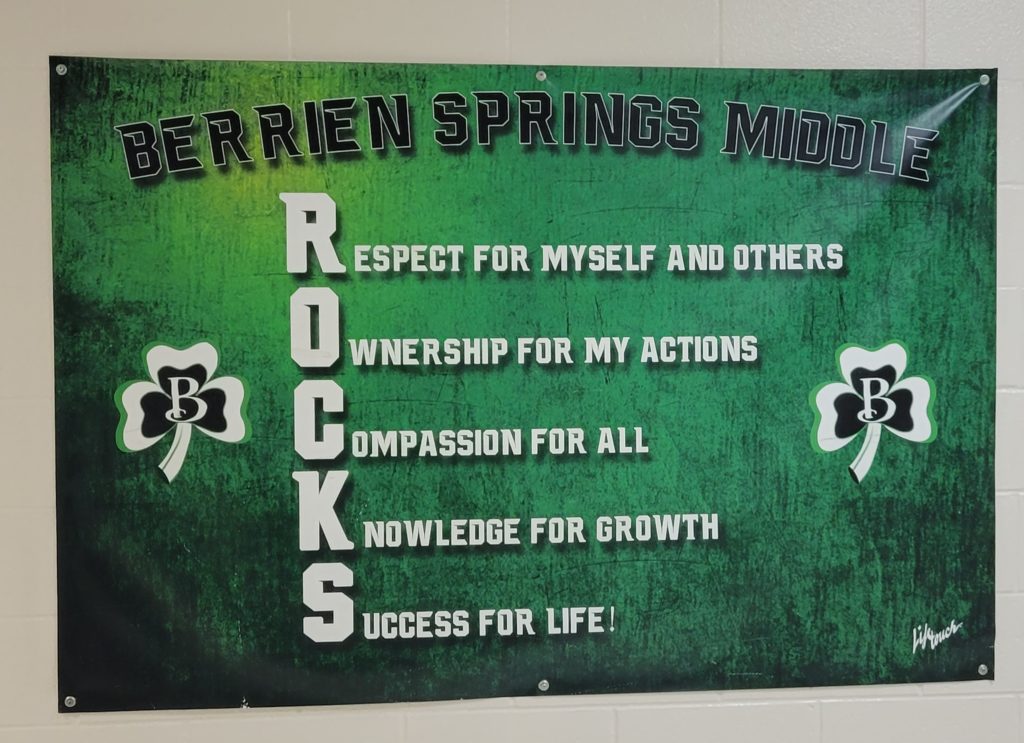
Because of their diverse and economically disadvantaged student demographic, BSPS has invested in PBIS support teacher positions throughout the district. These teachers work very hard to help students learn how to regulate their behavior and exemplify the ROCKS values. As a result of their PBIS program, all Berrien Springs students receive support and intervention based on their needs, and students who need it get individualized support. Students understand what is expected of them, and those expectations remain consistent. As Superintendent Eichberg shared: “My belief is that if you can’t maintain a safe and orderly environment, learning can’t happen.” Berrien Springs’ ROCKS values and PBIS framework encourage students to take ownership of their behavior and create a positive culture and environment for student-centered learning.
Standards-Based Grading
As a standards-based district, proficiency scales or learning scales are displayed in BSPS classrooms to help students understand how to evaluate their own learning and monitor their progress. Proficiency scales help to emphasize the importance of demonstrating competency or mastery of learning. While some BSPS teachers use general proficiency scales that can apply to any standard, the district is moving toward what some other teachers do: tailor the scales to specific standards to help students understand precisely what demonstrating mastery or proficiency looks like.
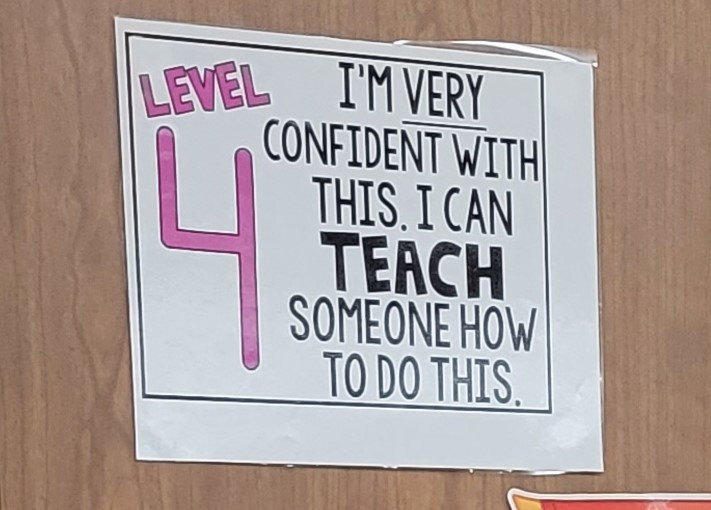
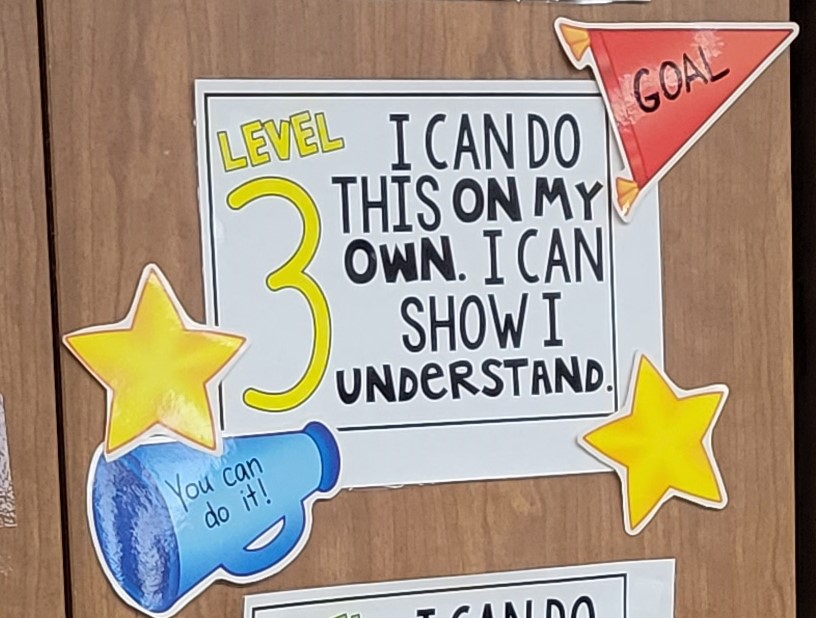
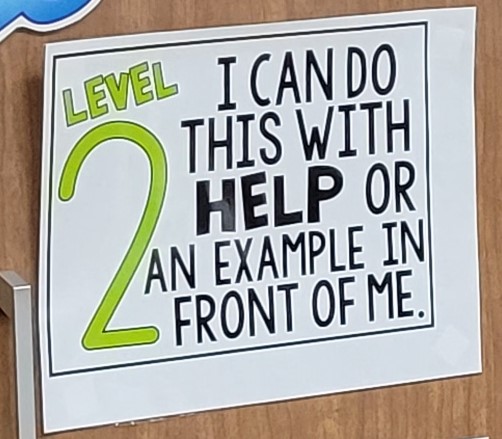
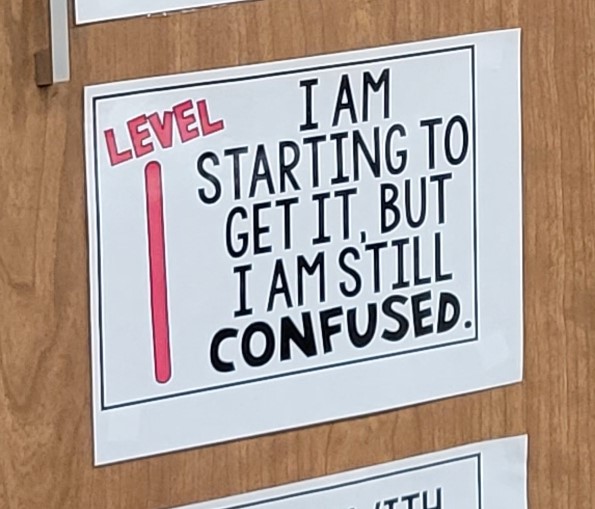
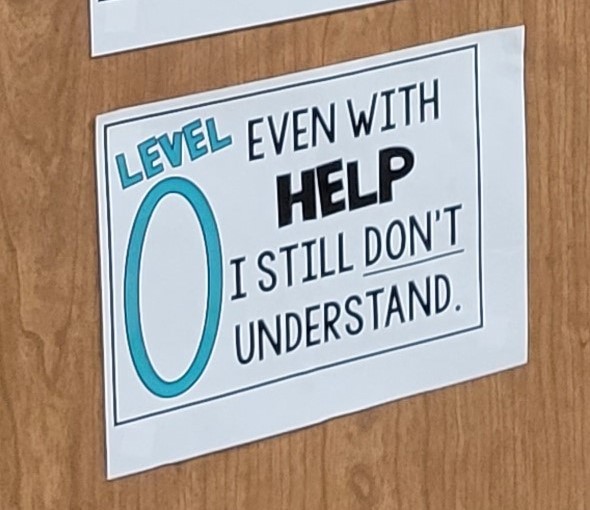
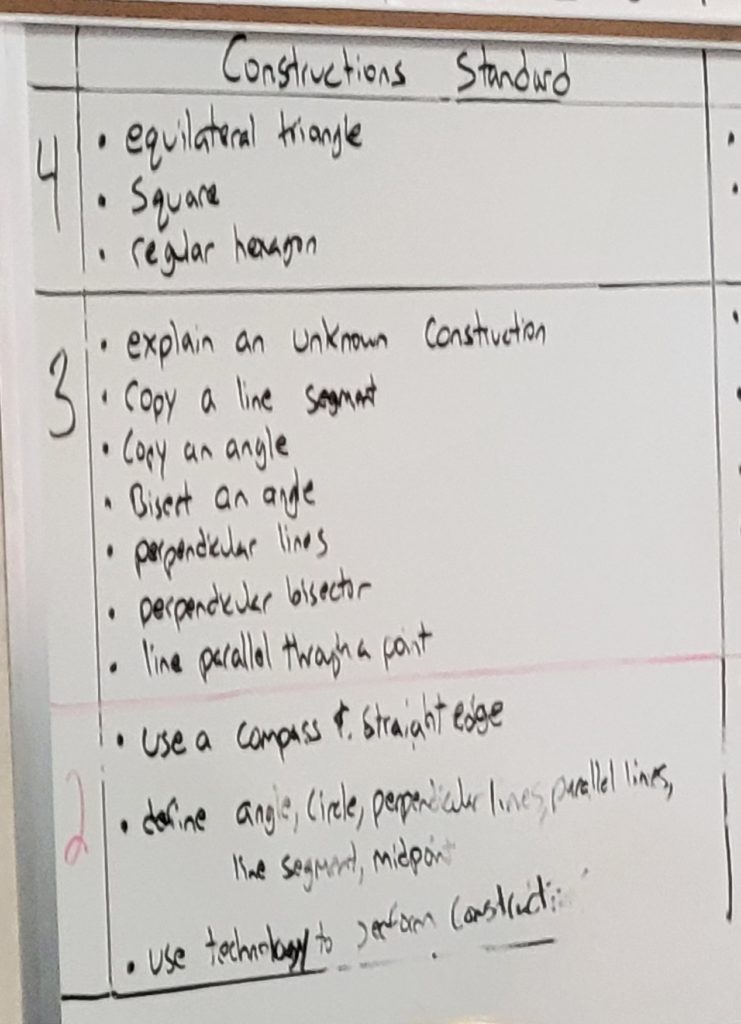
In order to make standards-based grading work, Schoology, Berrien Springs’ learning management system (LMS), is used by teachers and students to track results from both formative and summative assessments and progress toward standards represented on a 1-4 Marzano scale. Powerschool, their student information system (SIS), houses students’ numerically scaled progress and also translates these numbers to a traditional A-F letter grade for report cards. In a standards-based grading system like Berrien Springs’, students are better equipped to understand and articulate where they are in their progression of learning in the midst of the learning process. For example, a BSPS senior noted how letter grades seem very finalized, like they represent her worth as a student. However, she feels that a numerical score of 1-4 more closely reflects where she is in her progression of learning, what she needs to do to improve, and how much learning she has left to do.
Through the use of proficiency scales, BSPS students and teachers are better equipped to talk about learning and to see learning as a progression. The same student above described how standards-based grading has allowed her to more accurately convey her learning. She has had opportunities to retake tests in order to demonstrate mastery at a later date. While she admitted that some students take advantage of opportunities to retake tests, she explained that providing multiple opportunities to demonstrate proficiency affords students the ability to learn at their own pace. Superintendent Eichberg stressed that this is precisely what they want for students: “We want students to be able to talk about their learning. It’s just not about the grade. It’s not about the end result. It’s about what’s happening along the way with the learner.” When learning is student-centered, students can confidently talk about their learning and are active participants in the learning process.
“We want students to be able to talk about their learning. It’s just not about the grade. It’s not about the end result. It’s about what’s happening along the way with the learner.”
Dave Eichberg, Berrien Springs Public Schools superintendent
Learning is Student-Centered at Mars and Sylvester Elementary
Choice, voice, and learner agency were apparent throughout the Michigan Virtual Learning Research Institute (MVLRI) team’s visit to both Mars and Sylvester Elementary Schools. Despite what the MVLRI research team was able to capture through observations, these student-centered classrooms don’t actually look very different from any other classroom. What makes them student-centered is more about how the classroom and/or building functions. As Berrien Springs curriculum director Angie Cramer noted: “I don’t think people realize that it [being student-centered] is not this huge massive shift in what we do. It’s just being more intentional about what we do.”
Classroom behavior expectations, developed together as a class, were displayed and signed by all students. Based on the acronym “I PICK,” students had opportunities to choose their own book to read, keeping in mind the book’s purpose as well as their interest, comprehension, and knowledge of the words in the book. Directions were clearly displayed throughout the room, allowing students to be more self-directed—a foundational piece to developing and exercising student agency. Based on their needs, students worked individually, with a partner, or in a small group with direct instruction provided by their teacher to practice their sight words. Each student had their own large metal key ring containing cards with appropriately leveled sight words hung on it. Based on choice, students practiced writing and working with their sight words in one of three different ways: forming the words with waxy sticks, writing them out with big crayons, or using letter stamps to spell each word. Throughout different learning spaces within classrooms, students worked on various activities such as word work, listening to books being read to them on an iPad, and reading independently.
“I don’t think people realize that it [being student-centered] is not this huge massive shift in what we do. It’s just being more intentional about what we do.”
Angie Cramer, Berrien Springs Public Schools curriculum director
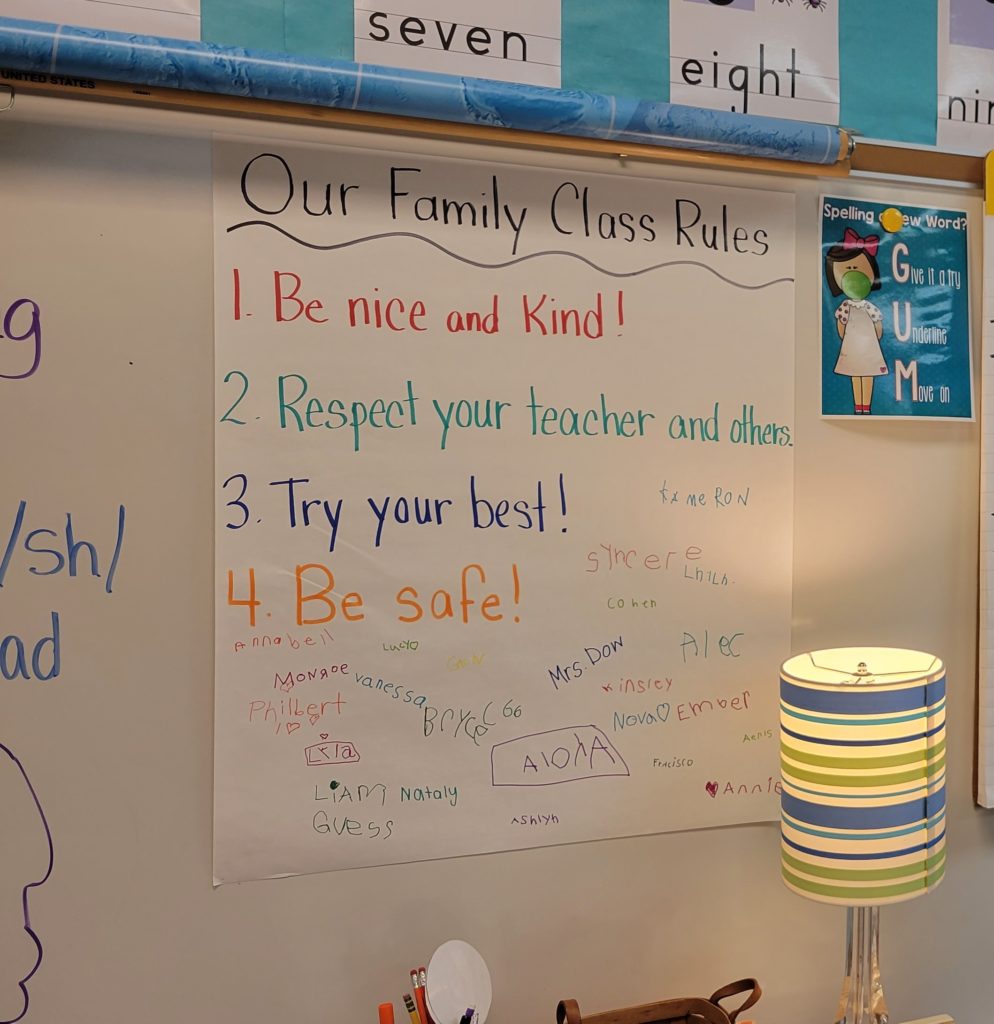
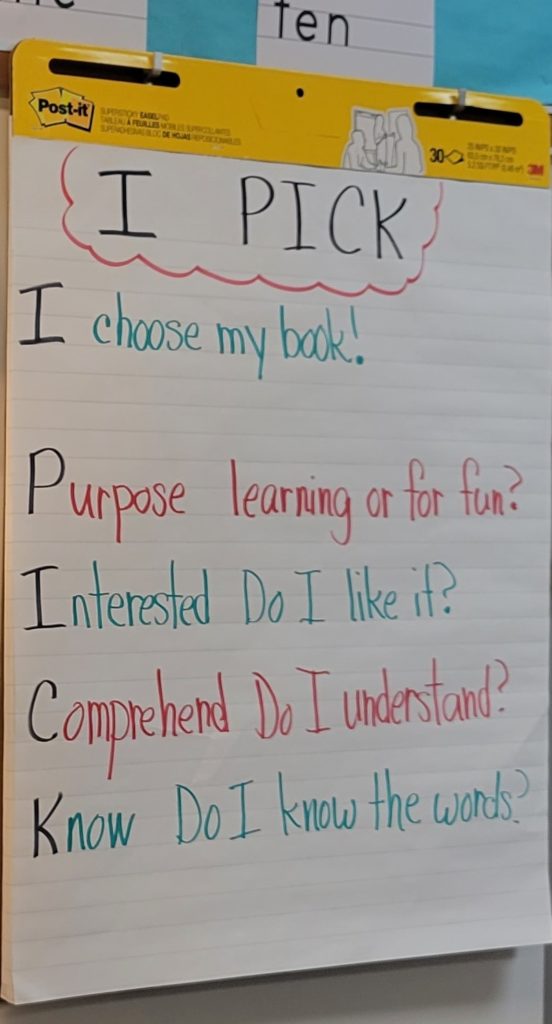
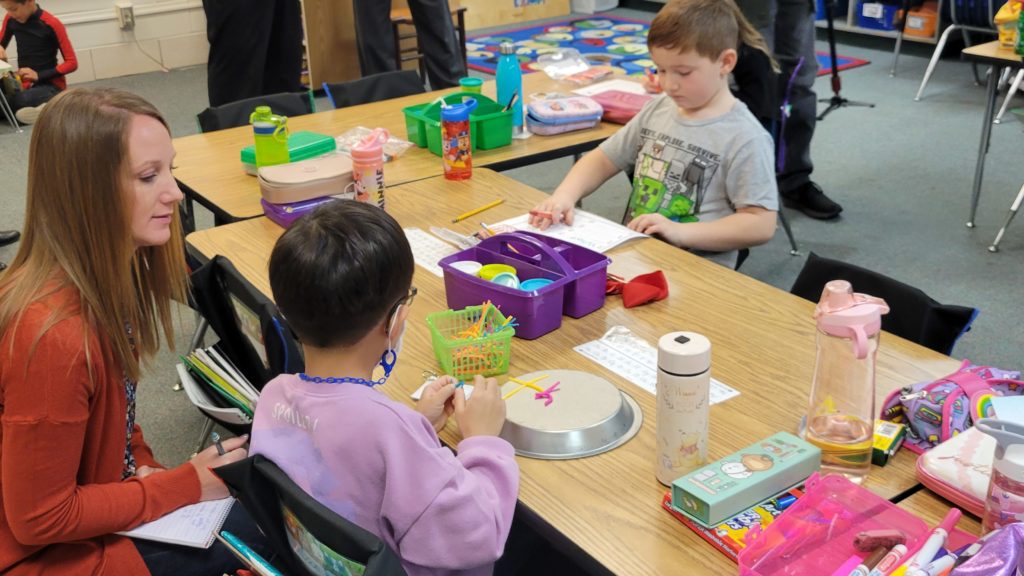
Social-Emotional Learning
Social-emotional learning (SEL) is a big part of the learning process at both Mars and Sylvester Elementary. SEL instruction takes place daily with individual students as well as with small groups of students. In response to the SEL challenges that students are experiencing, these schools have implemented a program called True Success which helps to tie together their focus on both PBIS and SEL and also brings in a component of literacy instruction. True Success skills and lessons are provided to all staff so that SEL is not only a focus in individual or small group instruction but in the classroom as well. Mars Elementary Principal Dee Voss shared that she has seen a shift in student behavior and well-being since implementing this program.
At Sylvester Elementary, Zones of Regulation, a social-emotional learning framework and pathway to regulation, gives both students and staff a common language to describe and understand others’ emotions. Having a common language helps staff more effectively work with students as they focus on students’ individual needs, creating the conditions for them to be successful. The school established a trauma room, which serves as a space where these personalized interventions can take place as needed. Leading by example for others, Sylvester Elementary principal Amy Williams shared how she uses this space daily to provide individualized intervention for a student who needs extra physical exertion in order to be able to be focused and ready to learn in the classroom. Two therapy dogs—Otis and Remy—also spend time with students providing emotional support throughout the school day.
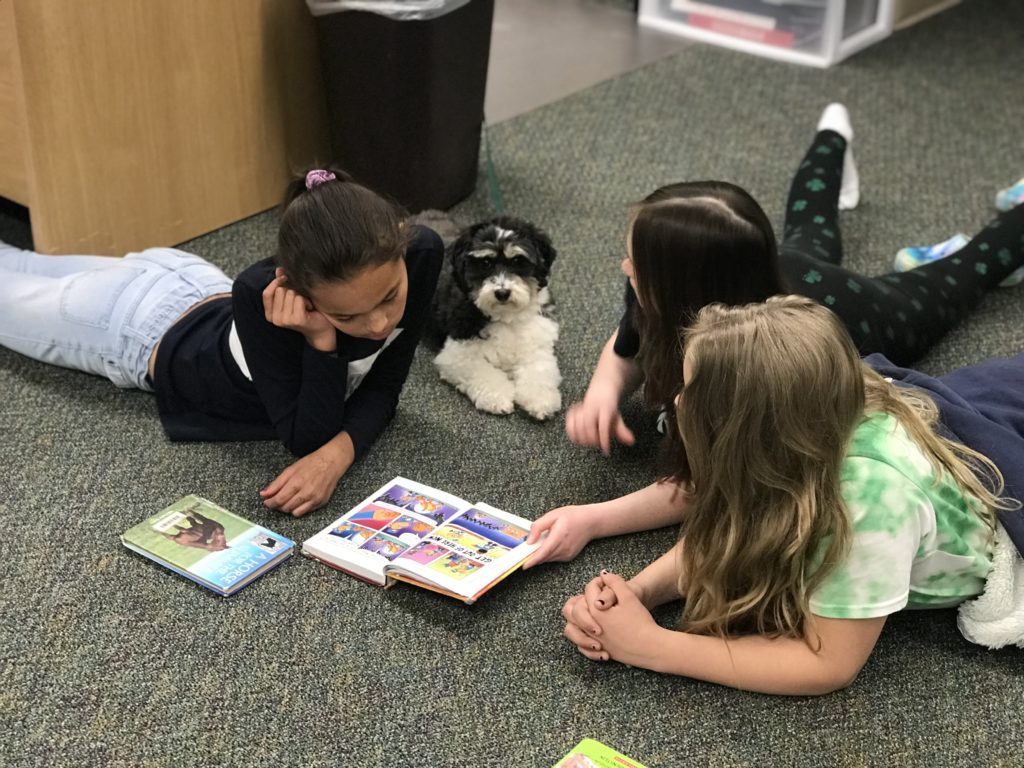
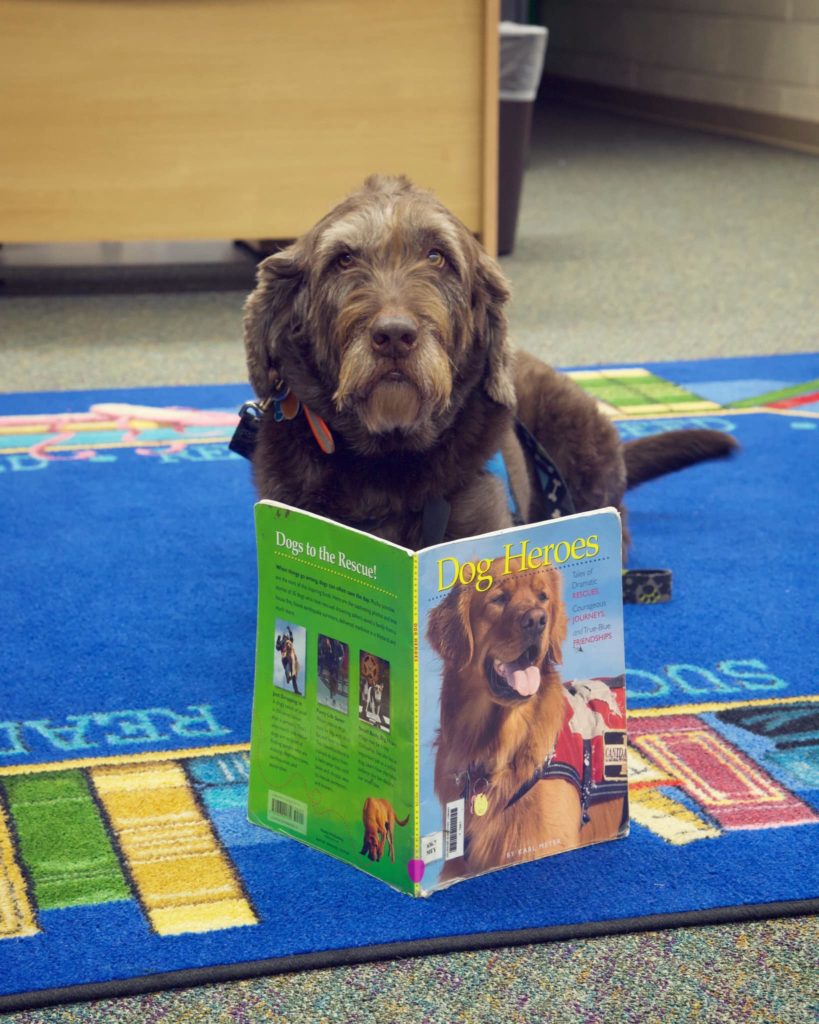
Students WIN with What I Need Time
When learning is student-centered, teachers frequently collect assessment data (summative and formative). Data become a part of the learning process and are used to adjust instruction for individual students. At both Mars Elementary and Sylvester Elementary, assessment data (NWEA, AIMSweb, iXL) are used to place students into specific intervention blocks called WIN or “What I Need.” During their daily WIN time, everything in the building stops for 40 minutes and students move to their WIN group. The size of each WIN group varies and is based on what students need. For example, students who are significantly behind grade level may be working one-on-one with a highly qualified teacher or in a small group of up to three students. As Sylvester Elementary Principal Amy Williams explained: “The way that we’re able to get such small-sized WIN groups is we have enrichment groups. So our music teacher and our gym teacher have about 26 kids apiece. During their WIN time, it’s all choice-driven.”
In their WIN groups, students have three goals: (1) become better readers, writers, and speakers; (2) graduate to an enrichment group; and (3) score “proficient” on the M-Step, Michigan’s standardized state test. The elementary school leaders adapted WIN time from what is being done at other schools—in fact, WIN time actually started in 2018-19 with a pilot program at Berrien Springs Middle School. Berrien Springs has invested in programming and additional positions among their staff in order to give students the individualized support they need. The social and emotional supports and interventions that are provided to students are great examples of student-centered learning—recognizing that students need personalized supports in order to create the conditions for successful learning.
Students have Choices at Berrien Springs Middle School
Choice—when students choose the learning path or process that works best for them—is one of the key tenets of student-centered learning. At Berrien Springs Middle School (BSMS), teachers understand that not all students learn in the same way, so students are provided with choices in order to make learning more equitable and student-centered. As the MVLRI research team visited classrooms at the middle school, it was obvious that providing choices to students was a priority. Walking through the halls, student artwork and projects were displayed, reflecting choices in topics and outputs that demonstrate their learning. When visiting classrooms, students described how seeing the projects that other students complete and present is helpful to give them ideas for future projects and to allow them to demonstrate their learning in a more meaningful way. As one middle school student shared: “[Having choices] is helpful because it makes you feel better about the work you are doing. You like it more, and it helps you grow as a learner.”
Students also have choices when it comes to the courses they take. At BSMS, students can choose to take some of their courses virtually, to take courses that will give them high school credit, and/or to take courses based on their individual interests. Berrien Springs uses Project Lead The Way® (PLTW) curriculum K-12. At the elementary level, PLTW Launch is used for their science curriculum; the high school has a PLTW STEM program that includes pathways in Engineering, Biomedical Science, and Computer Science; and at the middle school, students can choose to take semester electives through a PLTW program called Gateway. Through the completion of PLTW projects and the problem-based curriculum, students learn by doing. Students are empowered to apply their knowledge to problems, challenged to think critically, and encouraged to lead their own learning.
BSMS uses the World of Work® curriculum in their Career courses. In Career courses, middle school students are introduced to the RIASEC Career Test to help determine what careers best fit their personality traits. Students’ RIASEC codes are discussed throughout the year. A middle school student admitted that knowing their RIASEC test codes has “really helped us [students] figure out what helped us learn best and how teachers can help us learn, too.” Middle school students are developing skills needed for self-advocacy—knowledge of themselves as a learner and the ability to communicate what they need in order to be successful. This is also evidence of student voice, another tenet of student-centered learning that the middle school is working towards. Not only does knowing their RIASEC test code help students, but it also helps teachers understand the individual needs of their students and how they learn best. Knowing this helps teachers personalize instruction for individual students and for individual classes. When teachers adjust their instruction and/or personalize learning based on non-academic information (such as a RIASEC test code), they are making learning student-centered.
“[Having choices] is helpful because it makes you feel better about the work you are doing. You like it more, and it helps you grow as a learner.”
Berrien Springs Middle School student
Programs and Pathways at Berrien Springs High School
Berrien Springs High School (BSHS) offers many different programs, pathways, and options for students. These options give students the ability to pursue areas of their interests and to have hands-on learning in high school. One such opportunity is a Co-Op program that BSHS has with Blossomland Learning Center, a special education school just down the road from the Berrien Springs campus at Berrien RESA. As part of the Blossomland program, students work in a compensated capacity in a school setting with severely physically and mentally disabled students. Berrien Springs students are supported throughout the program and go through training in order to prepare them for the experience. A BSHS student described the program: “I am a part of the Co-op program, which is where we allow students to work during the day instead of taking classes. I get to work in a classroom with great kids and great staff. I’ve learned a lot about how to deal with situations that I wouldn’t get the opportunity to consider in a regular high school setting. It’s genuinely been one of the most rewarding things that I’ve gotten out of my high school experience, and I’ve only been there for two or three months now.” As she proudly shared her experience in this program with the MVLRI research team, the other students and adults in the room listened intently as it was obvious how impactful this program has been for her. When learning is allowed to extend beyond the walls of the classroom, the impact it can have on students may be even more powerful than anticipated—and is undoubtedly student-centered.
Career and Technical Education Pathways
Berrien Springs offers junior and senior high school students four different career and technical education (CTE) courses: Building Trades, Criminal Justice, EMT-Medic, and Fire Fighting. These pathway options allow students to get hands-on learning—at their own pace—while preparing themselves to be career and college ready. Some of these pathways enable students to earn certifications upon course completion. For example, students in the EMT program have the ability to sit for their licensure test upon graduation, and with successful completion, earn their certification and possibly have a job lined up upon graduation.
According to one high school student, the CTE program gives students opportunities to learn more about the things they are personally interested in or are curious about: “I did the CTE program last year for firefighting. It was something I knew nothing about, but I saw that it offered a lot of skills that could better me as a person. So I completed the course, and now I can be a certified firefighter when I turn 18.” The CTE program also provided him with opportunities to make connections with fire chiefs, police chiefs, and public safety chiefs while interacting with many other members of the Berrien Springs community.
Another student admitted that high school students, herself included, often don’t know what they want to do for a career; however, through their CTE program, students have opportunities to explore their interests and possible career options: “It [our CTE program] gives us an opportunity to branch out and do different things. It helps us decide if that’s what we want to do in the future.” These CTE pathways allow students to explore their interests in a “safe” environment before actually going to college and declaring a major. Some students find out that what they thought they were interested in, they actually aren’t.
BSHS students also have the option to take additional CTE courses through the Berrien County RESA’s CTE programs. The Berrien County CTE offers additional pathways including Arts and Communication; Business, Management, Marketing, and Technology; Engineering, Manufacturing, and Industrial Technology; Health Science; Human Services; and Agriscience and Natural Resources. Whether students are taking CTE courses through the Berrien County RESA or one of the BSHS CTE courses, many are not taught right on the Berrien Springs campus. In terms of the logistics of the CTE program and getting students where they need to be, a CTE student shared: “Our school has transportation for us. They take us and they bring us back every single day…they are really on top of making sure that we have everything we need.”
Early Middle College and Flexible Pacing Options
Students who apply, interview, and are accepted into the Berrien County Early Middle College Program are able to earn credit for taking college courses in high school, which are paid for by the school district. In partnership with Lake Michigan College and Southwestern Michigan College, this program gives students the ability to extend their high school experience by earning not only their high school diploma, but also earning substantial transferable college credits, a technical or career certificate, and the opportunity to begin a registered apprenticeship or earn an associate degree.
In addition to earning college credit in high school, BSHS grants credit to students who can demonstrate a reasonable level of mastery (78% or better on an exam) in courses in which they are not enrolled. Credits are awarded on a “pass” basis only, count toward fulfillment of subject area/sequence requirements, but are not included in students’ grade point average. Superintendent Eichberg explained that the option to “test out” of courses in this manner gives students the ability to move on when they are ready: “We allow kids to accelerate if they can demonstrate proficiency and mastery.” In this way, individual student data are used to facilitate the progression of students based on the demonstration of competency—not simply by moving through content on a predetermined schedule. This also gives students the ability to earn credits towards early graduation or to make room in their schedule for courses in which they are more interested. The opportunities that Berrien Springs Public Schools provides to students allow them to choose from many different pathways, have a voice in shaping their learning, and experience learning that is relevant, meaningful, and mastery-based. This is student-centered learning.
Learner Agency, Self-Advocacy, and Relationships
When learning is highly student-centered, not only do educators monitor student needs and adjust learning experiences and instruction accordingly, students monitor their own needs and advocate for themselves. In their badge on progress monitoring and helping students set their goals, Digital Promise explains that learner agency has two main components: (1) knowledge of oneself as a learner, and (2) the learner’s ability to articulate, create, or ask for the conditions necessary to meet one’s learning needs. Through standards-based grading and an emphasis on proficiency or learning scales, Berrien Springs students develop the skills necessary to possess that knowledge of themselves as learners, what they need to be successful, as well as the ability to advocate for themselves.
As explained by a BSHS junior, most teachers lay out performance expectations in the form of a rubric at the beginning of each project/assignment/lesson which tells them exactly what they need to do to achieve each level of proficiency. They go over this again at the end of the unit, and some teachers also check in periodically with students regarding their progress and understanding throughout the unit. During a small group conversation between BSHS students, educators, and the MVLRI research team, one senior shared that grades are not merely assigned without justification—rubrics paired with proficiency scales mean grades aren’t left up for interpretation: “I genuinely believe that I could go to any of the teachers I’ve had in my high school career and fight for my grade if I feel like I should have done better than what they gave me.” Another student added, “They actually encourage us to do that.” BSHS students reported that teachers consistently reiterate that students should come to see them if they ever have an issue with a grade. Another student added: “And that’s why I think a lot of people don’t like standards-based grading because it has to be self-led. You can’t sit back—you have to be proactive when it comes to your grade.” To hear students talk about the agency they have for their learning, the ownership they feel, and their comfort level in being involved in the learning process—that is the point of making learning student-centered: learning is not done to students, students are a part of the learning process.
In a student-centered learning environment, grades become less about judgment from the teacher, but become more about evidence of learning. As a result, students must become comfortable advocating for themselves. In order to have this level of comfort between students and teachers, establishing trusting, personal relationships are key. “I feel more inclined to talk to my teachers when I have a personal relationship with them. You learn better when you like who you are learning from,” reflected a BSHS student. According to several students, when teachers talk to them as people, not as subordinates, it makes them feel like it’s not always about learning. It can be as simple as teachers sharing how they are doing, something about their morning routine, or a funny personal story. “The teachers who greet me the most or that I see the most in the hallways are the ones who I form the closest relationships with,” reported another BSHS student. This student added that when teachers make an effort to try and get to know him, to ask about things they know are going on in his life, this helps him to feel more connected to them. And as a result, he admitted that “I try to do more in their class, to do my best.”
“And that’s why I think a lot of people don’t like standards-based grading because it has to be self-led. You can’t sit back—you have to be proactive when it comes to your grade.”
Berrien Springs High School student
Virtual Learning Options
Situated on the Berrien Springs campus, Berrien Springs Virtual Academy is a virtual learning option for students in grades 1-12. Their grades 1-5 program allows parents to homeschool their child with the support of a certified teacher and offers a wide array of core academic classes through Lincoln Learning as well as elective classes through their Parent Partnership program. For students in grades 6-12, the Virtual Academy offers an extensive variety of online courses including Virtual Plus Course offerings, homeschool partnership electives, PLTW®, CTE, dual enrollment, and co-op/internships.
Steve Spenner, principal of Berrien Springs Middle School, explained that at the secondary level, “having the Virtual Academy here on campus allows our kids choice.” Students are able to move throughout the campus to take virtual courses that may not be offered at the middle school or high school, or they may be courses that don’t fit into their face-to-face schedule. At the same time, virtual students can come to the middle school or high school and take some courses in person. Being situated on a single campus affords students so many options. Virtual Academy staff work very hard to ensure that their program meets the needs of all students, and is all about choice and flexibility for both students and parents. “We’re really able to give kids what they need and how they need it,” remarked Berrien Springs Virtual Academy Principal Valerie Carr.
Berrien Springs not only offers its on-campus students a wide range of student-centered learning opportunities, they also offer several additional student-centered virtual learning options for students across the state of Michigan. West Michigan Virtual Academy provides students with a flexible and innovative approach to obtaining a high school diploma. Staff adapt to students’ individual needs, allowing them to learn at any time, any place, and at any pace—regardless of whether they learn at home or on their Battle Creek campus. Success Virtual Learning Academy is another online high school option for students ages 14-21 offering students a flexible schedule, self-paced virtual learning, and face-to-face support to fit students’ unique needs and learning styles. With the support of on-site educators, students are empowered to take full control of their education.
“We’re really able to give kids what they need and how they need it.”
Valerie Carr, Berrien Springs Virtual Academy principal
Link Learning
Another student-centered virtual learning option for students is Link Learning, a virtual high school for students ages 14-21. There are actually 16 Link Learning locations across the state of Michigan including three locations in Michigan’s Upper Peninsula—Escanaba, Marquette, and Menominee. Link Learning locations are established in partnership with Berrien Springs Public Schools and the local intermediate school district (ISD) where each facility is located. In total, these locations serve approximately 1,749 students who upon graduation, receive a Berrien Springs Public Schools diploma. When the MVLRI research team arrived at the Alpine Link Learning location, located in Grand Rapids, Michigan, for an onsite visit, they walked into an expansive facility with high ceilings, bright colors, and an open, flexible space where students and staff interact. Link Learning students who choose to come in person to work on their courses or to get support from teachers, mentors, and/or other support staff have a variety of learning spaces from which they can choose.
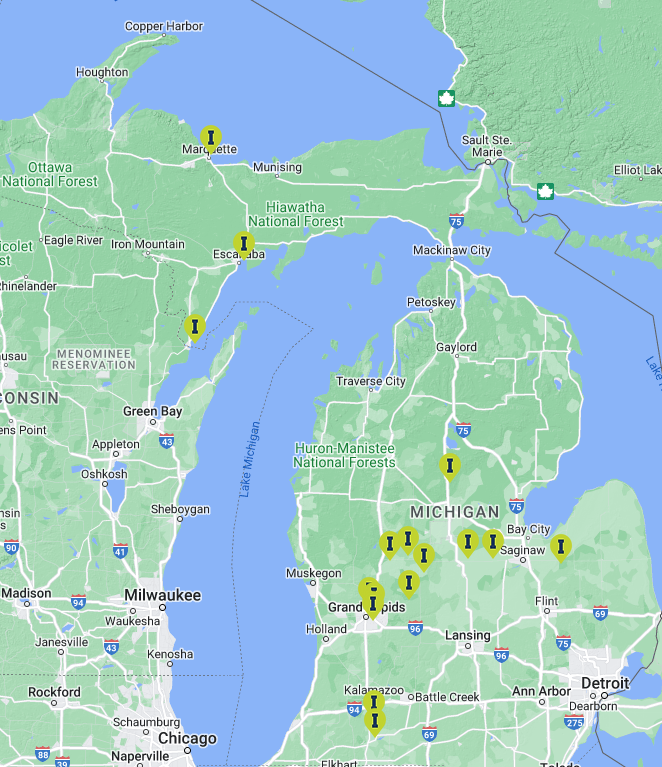
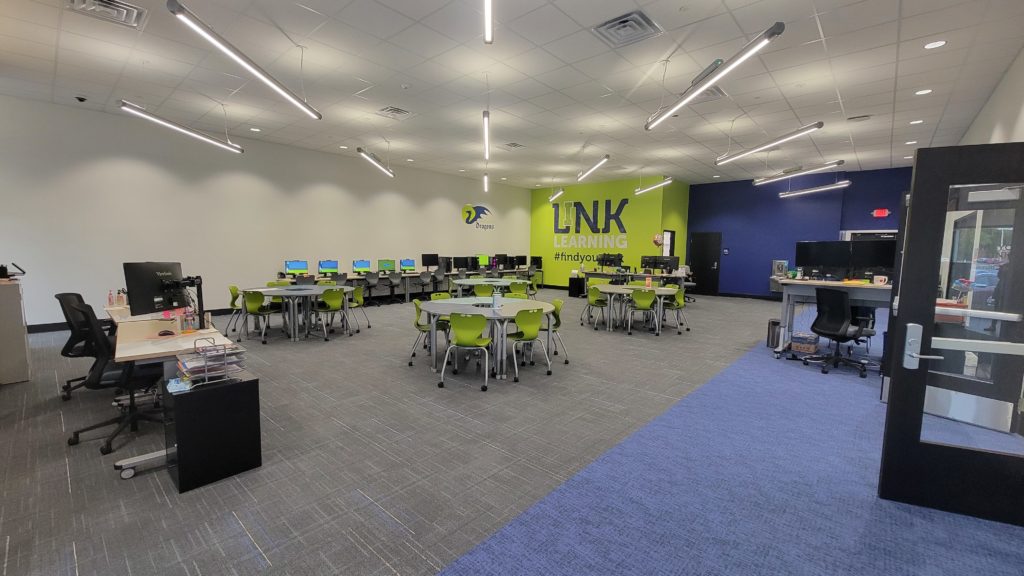
At Link Learning, staff pride themselves on their student-centered approach focused on meeting the needs of individual students. They realize that many students are there because of a lack of success in a traditional classroom as a result of not receiving the individualized approach and support that they need. Because of this, providing wraparound student supports is crucial. At Link Learning, staff take a dual support approach: each student has a teacher assigned to them as well as a mentor. The teacher is responsible for the student’s academic needs, and the mentor is responsible for providing behavioral support as well as serving as a liaison between the student, teacher, school, and parent (if the student is under the age of 18).
In addition to the support of a teacher and mentor, Link Learning provides students with English Language Learning (ELL) support, support from a social worker, and special education support as needed. In recent years, the program experienced an increase in enrollment for special education students, perhaps because of this support. “We have a really good special ed program. In fact, our special ed students, on average, perform better than our general education students because of that extra layer of support,” shared Executive Director of Link Learning Kristi Teall.
As well as providing students with the individualized supports they need, carefully monitoring student progress is a big part of Link Learning’s recipe for student success. Pulse, a district-developed data dashboard, is used to monitor student progress. Students take courses sequentially—one at a time—and work at their own pace with an expectation of maintaining regular progress within each course. On average, students complete about 3 ½ courses per year, although the goal is for each of them to complete closer to 12. Using Pulse, staff identify trends of student engagement and analyze different data points to determine where individual students are struggling, specifically. They have a multi-tiered system of support (MTSS) designed specifically for virtual learning and provide interventions based on the data collected. As Teall explained, the data that Pulse provides Link Learning staff sparks conversations about what the adults need to do to help support students: “Pulse was probably our first step in becoming student-centered. It is about looking at data to see what is going on with kids, trying to find out why some are or are not successful, and determining what we need to do to address some of those challenges that our students are facing.” Monitoring student data and adjusting learning experiences accordingly is one of the key tenets of a student-centered learning environment.
In addition to the flexibility to work at their own pace and in a place that is comfortable for them, students have choices in many other areas of their learning. Link Learning offers optional clubs that students can choose to participate in such as eSports, 3D printing, model building, anime, arts and crafts, and parenting. Students also have the option to take dual enrollment courses through Ferris State University, earning college credit while working towards their high school diploma. In addition, Kendall College of Arts and Design offers several courses designed specifically for Link Learning students.
At Link Learning, building relationships with students is at the core of who they are. According to staff, relationships have to come first. While some students do come on-site to the Link Learning locations for a quiet place to work or to get face-to-face support, more often than not, students work on their courses from home. This means that relationship building oftentimes occurs virtually, which requires mentors to get creative. A virtual educational development plan (EDP) is the mentors’ starting point in terms of relationship building. To build a student’s EDP, they focus on the individual student outside of the curriculum. Mentors listen to each student’s story, provide them with hope by supporting them, and personalize their support based on the student’s need. They reach out to all students at least once a week, even to those students who are on pace and doing well, to provide motivation and support. They find different ways to offer encouragement and to celebrate student success based on each student’s preferred method of recognition (e.g., a handwritten note sent home, a certificate, a social media shout-out, a parent text or call, etc.)
Not only is Link Learning’s approach to learning student-centered and personalized to each individual student and what they need, they also model the same approach with their staff. Staff have ownership of many of the structures that Link Learning has in place today. They are given a voice being included in many decision-making processes and are provided with individualized training and coaching. Staff also have opportunities to personalize their professional learning with optional micro-credentials based on what they are interested in and want to learn more about in order to increase their competency as educators. By experiencing personalized learning for themselves, staff have realized how important it is for learning to be personalized for their students.
“Pulse was probably our first step in becoming student-centered. It is about looking at data to see what is going on with kids, trying to find out why some are or are not successful, and determining what we need to do to address some of those challenges that our students are facing.”
Kristi Teall, executive director of Link Learning
Steadying the Ship with a Clear Vision for Student-Centered Learning
While Berrien Springs has established a strong student-centered foundation, reflecting many of the core tenets of student-centered learning, they believe they have a lot more work to do. They plan to build upon what they are currently doing to make learning more student-centered. General proficiency scales are being used in all classrooms to help measure learning on a scale from 1-4, allowing both teachers and students to more accurately discuss their level of proficiency as it relates to a learning target. However, their goal is for all teachers to create specific proficiency scales for individual learning targets that clearly indicate what students should be able to do at each level of proficiency. Berrien Springs is a standards-based district and uses Marzano’s conversion tool to convert numerical proficiency scores to letter grades when needed. Ultimately, as Superintendent Eichberg explained, they plan to use their foundation of standards-based grading to move them towards becoming competency-based, towards personalizing learning for every student.
In order to help their staff understand personalized learning and what it can mean for students, Berrien Springs is planning to restructure their professional learning system. By personalizing their professional development (PD), BSPS believes they will be able to more effectively meet the different learning needs of their teachers. They plan to implement badging and micro-credentialing for staff to help them hone in on personalized learning, but as Curriculum Director Angela Cramer stressed: “This shouldn’t turn into a ‘sit and get’ PD delivery. We need to focus on delivering our PD in a student-centered model to teachers.” Cramer also acknowledged the need for school districts to have more flexibility and autonomy to deliver professional development to teachers within the school day. She explained that providing 3 ½ days of PD to teachers at the beginning of the year, with an additional day in January, isn’t enough to allow BSPS to change the current system in any significant way. “So until the education system says, ‘We recognize we have to get away from how we do things and let our local school systems create systems that fit what they need and what’s best for their kids’—until school districts get that, it’s going to be very challenging to restructure that adult learning,” stressed Cramer. It is the hope of Berrien Springs administration that by personalizing their PD model in any way they can, staff will better understand what making learning student-centered can mean for students.
An additional area of focus for the district is being more intentional about teaching students how to take ownership of their learning and develop student agency. While several students that the MVLRI research team spoke to were clearly comfortable advocating for themselves and what they need as learners, BSPS wants to help all students develop these skills from an early age. Administrators recognize the importance of modeling for teachers what they hope teachers will, in turn, do with their students—stressing the value of teachers receiving effective feedback, of showing them where they are on a rubric or proficiency scale rather than just stating they are doing a “great job.” Administrators encourage teachers to prove that they are meeting the standards outlined in their evaluations. BSHS Principal Ryan Pesce explained how he hopes that this translates into teachers emphasizing the same skills with their students: “We are modeling this for teachers and hope that this is how teachers will provide feedback for their students. In a student-centered environment, we look for that agency. We are meeting them where they are, because they’re all different.” In a student-centered learning environment, students are empowered to understand how they learn, to talk about the learning process, and to prove their learning in a way that makes sense to them.
As Berrien Springs Public Schools moves forward, pushing towards creating more student-centered learning opportunities for students, consistency will be paramount. Berrien Springs has always been innovative and encouraged staff to explore different ideas; however, they’ve also realized that support needs to come in the way of “steadying the ship,” too. They need to continue their work of solidifying their essential standards to create a consistent scope and sequence between buildings and programs, allowing students to easily move back and forth between programs as needed. The use of standards-based grading proficiency scales needs to be consistent between classrooms and throughout buildings so students hear consistent language and can talk about their learning, regardless of the classroom or program in which they are learning.
Professional development needs to be personalized and provided consistently throughout the year—from year to year—to establish consistent knowledge and skills among staff despite turnover. There should be consistency in what they are doing while still allowing autonomy within different programs and different buildings based on their individual needs. With passionate educators and a commitment to consistency and improvement from administrators, they will get there. Most importantly, as Superintendent Eichberg excitedly shared, “I’m seeing administrators and teachers who are beginning to see the art of teaching from the lens of the learner. And that’s making a huge difference.”
